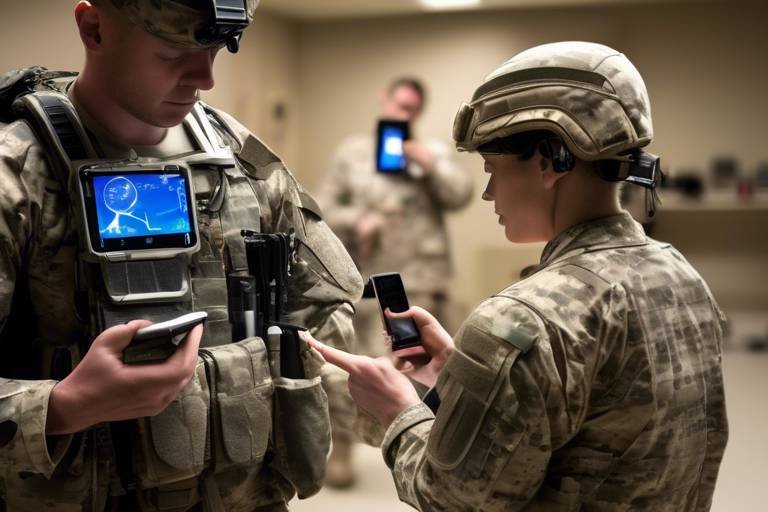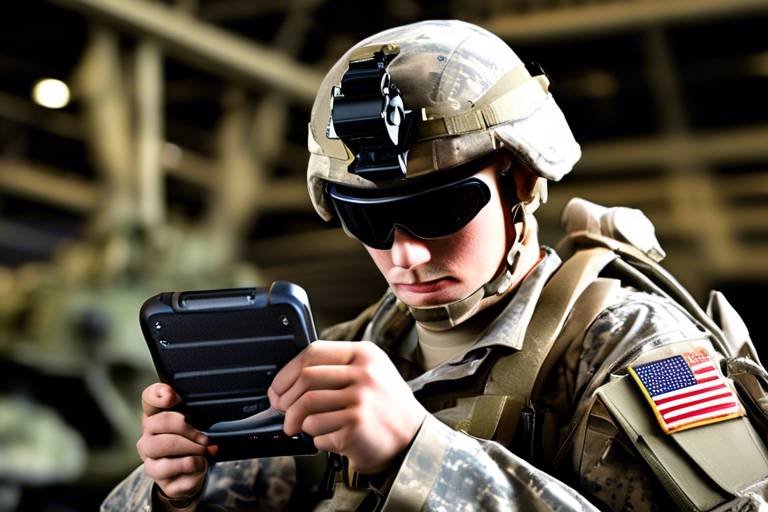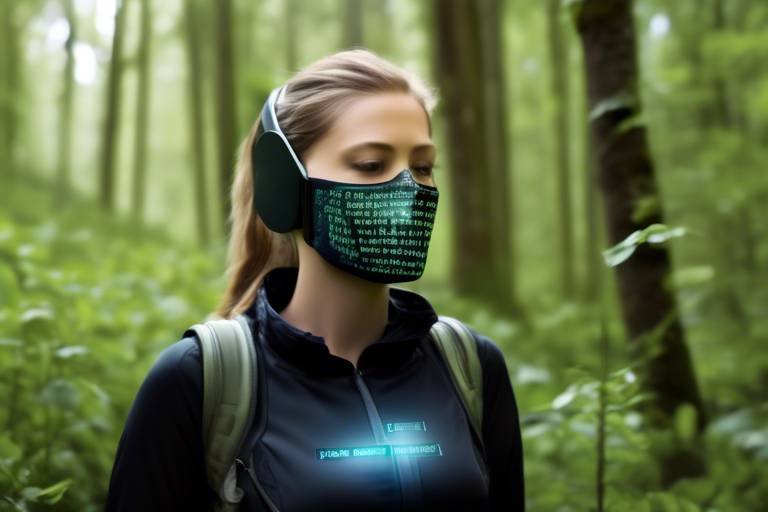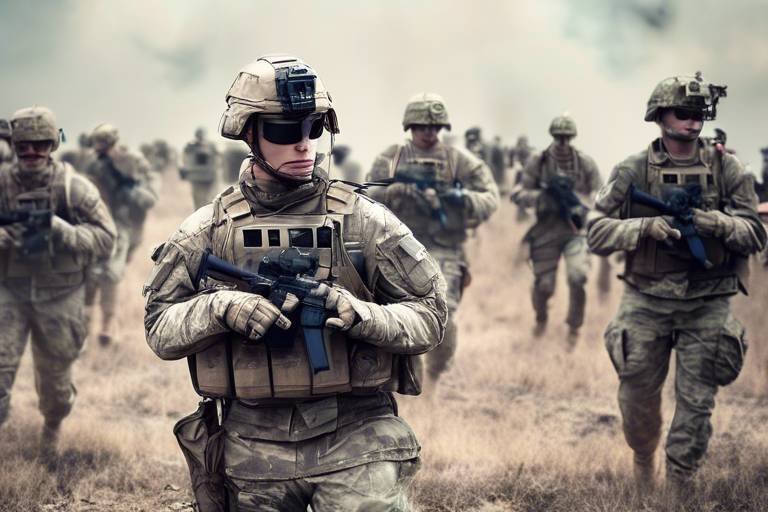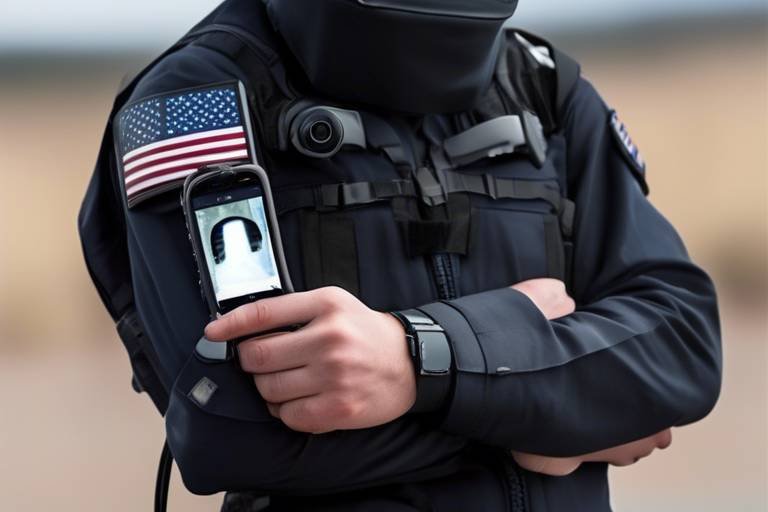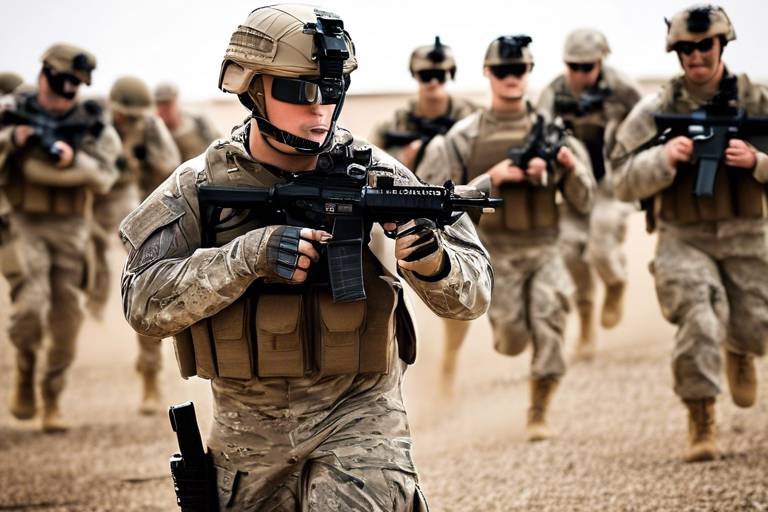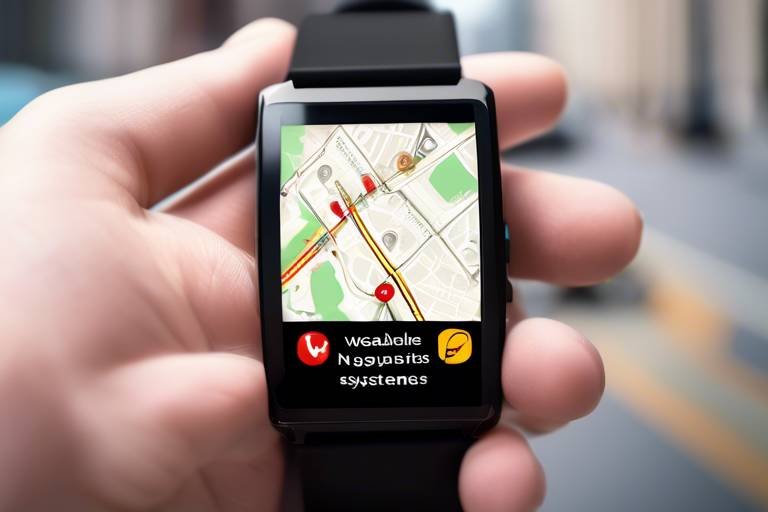How Wearable Technology is Revolutionizing Military Medicine
The battlefield is no longer just a place of combat; it’s evolving into a high-tech arena where wearable technology is becoming a game changer in military medicine. Imagine a world where soldiers can monitor their health in real-time, where medical emergencies can be addressed almost instantaneously, and where injury prevention is as precise as a laser. This is not science fiction; it's the reality we are stepping into today. With the integration of cutting-edge devices, the military is not just enhancing its operational capabilities but also ensuring the well-being of its personnel. This article dives deep into how these advancements are shaping the future of military healthcare.
Wearable devices are enabling real-time health monitoring of soldiers, allowing for immediate data collection on vital signs and physiological conditions. This capability is crucial on the battlefield, where every second counts. Imagine a soldier in the heat of combat; a wearable device can track their heart rate, body temperature, and even hydration levels, sending alerts to medics if something goes awry. This not only improves response times during medical emergencies but also empowers soldiers to take charge of their own health. With such technology, the military can transform the way it responds to medical crises, making it more proactive rather than reactive.
Injury prevention is another area where wearable technology shines. By continuously monitoring physical stress and fatigue levels, these devices help reduce the risk of injuries among military personnel during training and combat operations. Think of it as having a personal coach that knows when you’re pushing too hard. Wearable technology can track metrics like movement efficiency and fatigue, providing insights that help in adjusting training regimens to prevent injuries before they occur.
Wearable sensors provide valuable insights into soldiers' biomechanics, identifying movement patterns that could lead to injuries. This data is crucial for developing tailored training programs that enhance performance while ensuring safety. For instance, if a soldier's running form is off, leading to potential knee injuries, the wearable can flag this issue, prompting corrective measures. This proactive approach not only improves individual performance but also contributes to overall unit effectiveness.
Integrating wearable technology into training regimens enables data-driven adjustments, optimizing soldiers' physical conditioning. It’s like having a smart training partner that helps you avoid overexertion-related injuries during rigorous exercises. With real-time feedback, soldiers can modify their workouts based on immediate physiological responses, ensuring they are training effectively without risking their health.
Immediate feedback from wearable devices empowers soldiers to adjust their performance in real-time. This fosters a proactive approach to injury prevention and enhances overall health management. Imagine a soldier receiving alerts about their hydration levels or heart rate fluctuations; this information can prompt them to take necessary actions before a minor issue escalates into a serious problem.
The incorporation of telemedicine with wearable technology allows for remote consultations and continuous health monitoring. This is particularly beneficial for soldiers stationed in isolated environments, where access to medical facilities may be limited. With the ability to connect with healthcare providers virtually, soldiers can receive timely medical advice and support, ensuring they are not alone in managing their health.
Wearable technology enhances operational readiness by providing critical health data that informs commanders about troop readiness. This data aids in strategic planning and deployment decisions during missions, ensuring that leaders have a comprehensive understanding of their unit's health status. Imagine a commander being able to assess the physical condition of their troops at a glance, allowing for more informed decisions regarding mission assignments.
Advanced data analytics from wearable devices facilitate informed decision-making. Military leaders can efficiently assess the health and performance of their units, allowing for timely interventions when necessary. This capability not only improves individual soldier performance but also enhances overall mission success rates.
Wearable technology improves emergency response coordination by allowing medics to access real-time health data. This ensures that interventions are timely and tailored to individual soldier needs in crisis situations. For example, if a soldier collapses, medics can quickly retrieve their health metrics, enabling them to provide the most effective treatment possible without delay.
- What types of wearable technology are used in military medicine? Wearable devices include smartwatches, fitness trackers, and specialized sensors that monitor vital signs and physical performance.
- How does wearable technology improve soldier safety? By providing real-time health monitoring and data analytics, wearable technology helps prevent injuries and ensures timely medical interventions.
- Can wearable technology be used in remote locations? Yes, with the integration of telemedicine, soldiers in isolated areas can receive medical support and consultations through their wearable devices.
- What impact does wearable technology have on military training? It allows for data-driven training adjustments, optimizing physical conditioning and reducing the risk of injuries.
Advancements in Health Monitoring
In the ever-evolving landscape of military medicine, wearable technology stands out as a game-changer, particularly in the realm of health monitoring. Imagine a soldier on the battlefield, equipped with a device that continuously tracks vital signs like heart rate, blood pressure, and oxygen levels. This isn't science fiction—it's happening right now! These innovative devices are enabling real-time health monitoring, allowing for immediate data collection on physiological conditions. This capability is crucial, especially during medical emergencies where every second counts.
With wearable technology, commanders can gain instant insights into the health status of their troops. If a soldier experiences a sudden change in their vital signs, alerts can be sent immediately to medics, ensuring that help is on the way before the situation escalates. This proactive approach not only enhances the safety of soldiers but also significantly improves response times during critical moments on the battlefield.
Moreover, the data collected from these devices can be analyzed to identify trends and patterns in soldiers' health. For instance, if a group of soldiers consistently shows elevated heart rates during specific training exercises, this information can be used to adjust their training regimens. By doing so, commanders can prevent potential health issues before they arise, fostering a culture of preventive care within the military.
One of the most exciting aspects of these advancements is the integration of machine learning algorithms that can predict potential health risks based on historical data. For example, if a soldier has a history of dehydration during strenuous activities, the wearable device can monitor hydration levels and send alerts to the soldier to drink water before they reach a critical point. This kind of foresight is invaluable, especially in high-stakes environments.
In summary, the advancements in health monitoring through wearable technology are not just about collecting data; they are about transforming how military personnel manage their health in real-time. By providing immediate access to vital health metrics, these devices enhance not only individual soldier safety but also overall mission effectiveness. As we continue to explore the potential of this technology, the future of military medicine looks brighter than ever.
Injury Prevention Strategies
Wearable technology is not just a trend; it’s a game-changer in the realm of injury prevention for military personnel. Imagine soldiers equipped with devices that continuously monitor their physical stress and fatigue levels. This is not science fiction; it's happening now! By utilizing advanced sensors embedded in wearables, the military can gather critical data that helps reduce the risk of injuries during both training and combat operations.
One of the most significant advantages of these devices is their ability to conduct biomechanical analysis. Think of it as a coach that never sleeps, always watching and learning. Wearable sensors track movement patterns, pinpointing areas where soldiers might be at risk of injury. This information is invaluable, allowing for customized training programs designed to enhance performance while prioritizing safety. For instance, if a soldier's gait shows signs of strain, adjustments can be made to their training regimen to prevent potential injuries before they occur.
Moreover, the integration of wearable technology into military training programs fosters a data-driven approach. By analyzing the data collected from wearables, military trainers can make informed adjustments to optimize soldiers' physical conditioning. This proactive strategy helps mitigate the chances of overexertion-related injuries, which are all too common during rigorous exercises. In essence, wearables serve as a lifeline, providing real-time feedback that empowers soldiers to modify their performance on the fly. This immediate feedback loop not only enhances their training experience but also promotes a culture of health management within the ranks.
In addition to real-time feedback, wearables facilitate the incorporation of telemedicine. This means that even in the most isolated environments, soldiers can receive timely medical advice and support. Imagine a scenario where a soldier feels fatigued or notices an unusual pain; they can quickly consult a medical professional remotely, ensuring that they receive the necessary care without delay. This seamless integration of technology and healthcare is revolutionizing how military medicine operates, making it more efficient and responsive to the needs of soldiers.
Ultimately, the adoption of wearable technology in military settings is a strategic move towards a safer and healthier force. By focusing on injury prevention through advanced monitoring and data analytics, the military is not only enhancing the well-being of its personnel but also ensuring operational readiness. With soldiers better equipped to manage their health, the entire unit stands stronger, ready to face the challenges ahead.
- What types of wearable technology are used in military medicine? Wearable devices such as smartwatches, fitness trackers, and specialized health monitors are commonly used to track vital signs and physical activity.
- How does wearable technology help in injury prevention? By monitoring physical stress and fatigue levels, wearables can alert soldiers to potential risks, allowing for timely adjustments in their training and activities.
- Can telemedicine be integrated with wearable devices? Yes, wearable technology can facilitate remote consultations and continuous health monitoring, ensuring soldiers receive timely medical advice.
- What is biomechanical analysis? It involves using sensors to analyze movement patterns in order to identify risks for injuries and optimize training programs accordingly.
Biomechanical Analysis
In the realm of military medicine, stands out as a groundbreaking advancement, particularly when integrated with wearable technology. Imagine a soldier on the battlefield, their every movement being monitored in real-time, providing invaluable insights into their physical performance. This technology doesn't just track steps or heart rates; it delves deeper, analyzing movement patterns that could potentially lead to injuries. By utilizing wearable sensors, military personnel can gain a detailed understanding of their biomechanics, which is crucial for both performance enhancement and injury prevention.
These wearable devices are equipped with sophisticated sensors that capture data on various physical parameters. For instance, they can measure joint angles, gait patterns, and even muscle strain. This data is then analyzed to identify any irregularities or stress points that could predispose a soldier to injuries. Imagine the difference this makes: instead of waiting for an injury to occur, military trainers can proactively adjust training regimens based on real-time feedback. This tailored approach not only helps in enhancing the soldier's performance but also significantly reduces the risk of injuries that could sideline them during critical missions.
To illustrate how biomechanical analysis works, consider the following table that outlines the key parameters monitored by wearable sensors:
| Parameter | Description | Importance |
|---|---|---|
| Joint Angles | Measurement of angles in joints during movement. | Helps identify improper movement patterns that can lead to injury. |
| Gait Analysis | Assessment of walking and running patterns. | Reveals inefficiencies and potential injury risks. |
| Muscle Strain | Monitoring muscle exertion levels during activities. | Prevents overexertion and related injuries. |
Furthermore, the data collected from these wearable devices can be used to create customized training programs. For example, if a soldier's data indicates excessive strain on a particular joint, trainers can modify their exercises to focus on strengthening that area, ultimately enhancing the soldier's resilience and performance. This proactive approach is akin to having a personal coach that not only guides but also protects the athlete from potential setbacks.
Moreover, the integration of biomechanical analysis with wearable technology fosters a culture of self-awareness among soldiers. With immediate feedback available at their fingertips, soldiers can make real-time adjustments to their movements, whether it's correcting their posture or pacing themselves during rigorous training. This not only enhances their physical capabilities but also empowers them to take charge of their own health and safety.
In conclusion, biomechanical analysis through wearable technology is revolutionizing how military personnel train and operate. By identifying movement patterns that may lead to injuries and allowing for data-driven adjustments, this technology is not just a game changer; it's a life saver. As the military continues to embrace these advancements, we can expect to see a significant reduction in injuries, ultimately enhancing the overall effectiveness and readiness of our armed forces.
- What types of wearable devices are commonly used in military medicine?
Devices such as smartwatches, fitness trackers, and specialized sensors are frequently used to monitor soldiers' health and performance. - How does biomechanical analysis help in injury prevention?
By analyzing movement patterns and identifying potential risks, trainers can adjust training programs to minimize the likelihood of injuries. - Can wearable technology be used in combat situations?
Yes, wearable technology can provide real-time health data to medics, ensuring timely interventions in critical situations.
Data-Driven Training Programs
In the ever-evolving landscape of military training, the integration of wearable technology has ushered in a new era of . These programs leverage real-time data collected from wearable devices to create tailored training regimens that not only enhance performance but also prioritize the safety and well-being of soldiers. Imagine a soldier training in the field, equipped with a smart device that continuously monitors their heart rate, body temperature, and even hydration levels. This information is not just for show; it provides invaluable insights into the soldier's physical state and readiness for the rigors of combat.
By utilizing data analytics, military trainers can identify patterns and trends in soldiers' performance, enabling them to make informed adjustments to training protocols. For instance, if a soldier consistently shows signs of fatigue during specific exercises, trainers can modify their workload or introduce recovery periods to prevent overexertion. This proactive approach to training not only enhances individual performance but also contributes to overall unit readiness.
Moreover, the ability to analyze data over time allows for the identification of long-term trends in physical conditioning. Trainers can assess which exercises yield the best results for strength, endurance, and agility, and then refine their training programs accordingly. This cycle of continuous improvement ensures that soldiers are always at their peak performance level, ready to face any challenge that comes their way.
To illustrate the effectiveness of data-driven training programs, consider the following table that outlines key performance metrics before and after the implementation of wearable technology:
| Performance Metric | Before Wearable Tech | After Wearable Tech |
|---|---|---|
| Average Heart Rate | 145 bpm | 130 bpm |
| Injury Rate | 15% | 5% |
| Training Efficiency | 70% | 90% |
This table clearly demonstrates the significant improvements achieved through the use of data-driven training programs. A notable reduction in average heart rate indicates that soldiers are operating at a more efficient level, while the dramatic drop in injury rates speaks volumes about the effectiveness of tailored training strategies. Furthermore, an increase in training efficiency showcases how data analytics can streamline training processes, making them more effective than ever before.
In conclusion, the adoption of facilitated by wearable technology is not just a trend; it is a fundamental shift in how military training is approached. By prioritizing the health and performance of soldiers through real-time data analysis, military leaders are ensuring that their troops are not only prepared for the battlefield but also equipped to thrive in it.
- What types of wearable technology are used in military training? Wearable technology in military training includes devices that monitor heart rate, body temperature, hydration levels, and movement patterns.
- How does data from wearables improve soldier performance? Data from wearables allows trainers to tailor training programs based on individual performance metrics, reducing injury risk and enhancing overall efficiency.
- Can wearable technology be used in combat situations? Yes, wearable technology can be used in combat situations to monitor soldiers' health and provide real-time data for medical interventions.
- What are the long-term benefits of data-driven training? Long-term benefits include improved soldier readiness, reduced injury rates, and enhanced overall performance through continuous program refinement.
Feedback Mechanisms
In the fast-paced world of military operations, real-time feedback is not just a luxury; it's a necessity. Wearable technology has revolutionized how soldiers receive and act upon feedback regarding their physical condition and performance. Imagine a soldier on the battlefield, equipped with a device that continuously monitors their heart rate, body temperature, and even hydration levels. The moment any of these vital signs deviate from the norm, the device sends an alert, allowing the soldier to make immediate adjustments. This kind of proactive health management is akin to having a personal health coach right on your wrist.
Moreover, the integration of feedback mechanisms into military wearables fosters a culture of self-awareness and personal accountability. Soldiers can track their performance metrics and understand how their bodies respond to various stressors. For instance, if a soldier notices that their fatigue levels are peaking during a specific type of training, they can adjust their regimen to include more recovery time or different exercises. This not only enhances their performance but also significantly reduces the risk of injuries that can occur when one pushes their limits without understanding their body's signals.
Feedback from wearable devices can also be aggregated and analyzed at a unit level. This data-driven approach allows commanders to identify trends in soldier performance and health across the board. For example, if multiple soldiers report high fatigue levels during a particular training exercise, it may indicate that the exercise is too strenuous or poorly timed within their training cycle. Such insights can lead to strategic adjustments in training programs, ensuring that all personnel are operating at their best.
Furthermore, these feedback mechanisms can be tailored to each individual's needs. Soldiers can customize alerts based on their unique physiological responses, ensuring that they receive the most relevant information. This personalization fosters a sense of ownership over their health and performance, encouraging soldiers to take an active role in their well-being. In essence, wearable technology transforms soldiers from passive recipients of health advice into active participants in their health management.
With the ability to provide immediate feedback, these devices not only enhance individual soldier performance but also contribute to the overall effectiveness of military operations. By ensuring that soldiers are in optimal health and condition, wearable technology plays a critical role in maintaining operational readiness and success on the battlefield.
- What types of wearable technology are used in military medicine? Wearable technology in military medicine includes fitness trackers, heart rate monitors, smartwatches, and specialized sensors that monitor various health metrics.
- How does real-time feedback improve soldier performance? Real-time feedback allows soldiers to make immediate adjustments to their activities based on their physiological data, reducing the risk of injury and enhancing overall performance.
- Can wearable technology be used in remote locations? Yes! Many wearable devices are designed to function in isolated environments and can provide critical health data even without direct access to medical facilities.
- How does data from wearables inform military training programs? Data collected from wearables can reveal trends in soldier performance and health, allowing military leaders to adjust training programs to better suit the needs of their personnel.
Telemedicine Integration
In today's fast-paced military landscape, with wearable technology is proving to be a game changer. Imagine a soldier in a remote location, miles away from the nearest medical facility. In the past, that soldier would have to rely on limited resources and perhaps even wait hours for medical assistance. However, with the advent of wearable devices that monitor health metrics in real-time, soldiers can now receive immediate medical advice from healthcare professionals without leaving the battlefield.
These wearable devices, equipped with sensors that track vital signs such as heart rate, blood pressure, and oxygen levels, can transmit data directly to medical personnel. This means that doctors can assess a soldier's condition in real-time, allowing for prompt interventions that could potentially save lives. For instance, if a soldier's heart rate spikes dangerously high during a mission, medical staff can immediately provide guidance on how to manage the situation, whether that means taking a break, rehydrating, or even evacuating the soldier for further treatment.
Moreover, the integration of telemedicine and wearable tech enables continuous health monitoring, which is crucial during prolonged missions. By collecting data over time, medical teams can identify trends in a soldier's health, helping to predict potential issues before they escalate into serious problems. This proactive approach is akin to having a personal health coach who is always on call, ready to provide insights and recommendations based on real-time data.
Furthermore, the benefits of telemedicine integration extend beyond immediate medical care. It also fosters a culture of health awareness among soldiers. With access to their health data, soldiers become more engaged in their own well-being, learning to recognize the signs of fatigue or stress and understanding the importance of self-care. This shift in mindset can lead to better overall health and enhanced performance in high-pressure situations.
To illustrate the impact of telemedicine integration, consider the following table that compares traditional medical response times with those enhanced by wearable technology:
| Scenario | Traditional Response Time | Response Time with Wearable Tech |
|---|---|---|
| Emergency Situation | 1-3 hours | Immediate (seconds) |
| Routine Check-up | Days | Real-time Monitoring |
| Remote Consultation | Hours | Instant Access |
As we can see, the integration of telemedicine with wearable technology significantly reduces response times, which is crucial in life-threatening situations. This is not just about speed; it’s about improving outcomes and ensuring that soldiers have the best possible care, no matter where they are stationed. The future of military medicine looks bright as we continue to harness the power of technology to keep our troops safe and healthy.
- What is telemedicine integration in military medicine?
Telemedicine integration in military medicine refers to the use of telecommunication technology to provide medical care remotely, allowing soldiers to receive immediate medical advice and support while on the battlefield. - How do wearable devices assist in telemedicine?
Wearable devices monitor vital signs and other health metrics in real-time, transmitting this data to medical professionals who can provide timely interventions and advice. - What are the benefits of using telemedicine for soldiers?
Benefits include immediate access to medical care, continuous health monitoring, and increased health awareness among soldiers, leading to better overall health outcomes.
Enhancing Operational Readiness
Wearable technology is not just a trend; it's a game-changer for military operations. Imagine being able to monitor the health of soldiers in real time, ensuring they are fit and ready for action at a moment’s notice. This innovation is revolutionizing the way military leaders assess troop readiness, ultimately enhancing operational effectiveness. With the integration of wearable devices, commanders gain access to critical health data that informs their strategic planning and deployment decisions.
One of the standout features of wearable technology is its ability to provide real-time health monitoring. Soldiers equipped with these devices can have their vital signs, such as heart rate, temperature, and oxygen levels, tracked continuously. This data is invaluable; it allows commanders to make informed decisions about troop deployment based on the current health status of their personnel. For instance, if a soldier is showing signs of fatigue or distress, commanders can adjust assignments or provide immediate support, thereby preventing potential complications.
Moreover, the integration of data analytics into these wearable devices enhances decision-making processes. Advanced algorithms can analyze health metrics and predict potential health issues before they escalate. This capability not only keeps soldiers safe but also ensures that military units remain at peak performance levels. The ability to assess the health and performance of units efficiently allows military leaders to strategize effectively, ensuring that every operation is executed with precision.
Another critical aspect of enhancing operational readiness is the improvement of emergency response coordination. In crisis situations, every second counts. Wearable technology enables medics to access real-time health data, which is crucial for timely interventions. For example, if a soldier suffers an injury during combat, medics can instantly retrieve information about the soldier’s health status, allowing them to tailor their response to the soldier's specific needs. This level of preparedness can be the difference between life and death on the battlefield.
In addition to these advancements, the integration of wearable technology with telemedicine ensures that soldiers receive continuous support, even in isolated environments. This combination allows for remote consultations with medical professionals, ensuring that soldiers can access medical advice without delay. The ability to provide ongoing health assessments and recommendations while on the field not only boosts morale but also enhances the overall operational readiness of military units.
In conclusion, the incorporation of wearable technology into military medicine is a remarkable stride towards enhancing operational readiness. By providing real-time health data, improving emergency response coordination, and facilitating informed decision-making, these devices empower military leaders to maintain a fit and ready force. As we look to the future, the potential for further advancements in this field is immense, promising even greater improvements in the health and effectiveness of our armed forces.
- What types of wearable technology are used in military medicine?
Wearable technology includes devices like smartwatches, fitness trackers, and specialized health monitors that track vital signs and physical activity.
- How does wearable technology improve response times during emergencies?
By providing real-time health data, medics can make quicker, informed decisions about treatment options for injured soldiers.
- Can wearable technology prevent injuries among soldiers?
Yes, by monitoring physical stress and fatigue levels, these devices help identify risks and promote safer training practices.
Data Analytics for Decision Making
In the fast-paced world of military operations, data analytics has emerged as a game-changer, particularly when it comes to decision-making. The integration of wearable technology into the military not only collects data but also transforms it into actionable insights that can significantly impact the effectiveness and safety of troops in the field. Imagine being able to predict potential health issues before they escalate into serious problems—this is the power of data analytics!
Wearable devices continuously gather a wealth of information about soldiers' physiological conditions, such as heart rate, temperature, and even hydration levels. This data is then processed using sophisticated algorithms that analyze trends and anomalies. For military leaders, this means having a real-time overview of their personnel’s health status, which is crucial for strategic planning. It’s like having a digital twin of each soldier, providing insights that can help in making informed decisions.
Moreover, the use of predictive analytics allows commanders to foresee potential issues related to troop readiness. By examining historical data alongside real-time metrics, leaders can identify patterns that may indicate fatigue or stress-related risks. For instance, if a pattern shows that soldiers participating in specific training exercises tend to experience higher fatigue levels, adjustments can be made to training regimens to mitigate these risks. This proactive approach not only enhances the safety of the soldiers but also ensures that they are always mission-ready.
To illustrate this point further, consider the following table that summarizes how data analytics contributes to decision-making in military settings:
| Aspect | Impact |
|---|---|
| Real-Time Health Monitoring | Immediate access to soldiers' health data aids in quick decision-making during operations. |
| Predictive Analytics | Identifies trends that could lead to injuries or health issues, allowing for preventive measures. |
| Resource Allocation | Optimizes the deployment of medical resources based on real-time data. |
| Training Adjustments | Facilitates data-driven modifications to training programs to enhance soldier performance. |
In addition to these benefits, data analytics also plays a vital role in enhancing communication between different units. When health data is shared across teams, it fosters a collaborative environment where everyone is informed and prepared. This is particularly important during joint operations where multiple units must work together seamlessly. The ability to share real-time health analytics can mean the difference between success and failure in critical missions.
In conclusion, the integration of data analytics into military decision-making processes is not just a technological advancement; it’s a vital component that enhances operational effectiveness. By leveraging data from wearable devices, military leaders can make informed choices that prioritize the health and readiness of their troops, ultimately leading to greater mission success.
- What types of wearable technology are used in military medicine? Wearable technology in military medicine includes devices that monitor vital signs, track physical activity, and assess environmental conditions.
- How does data analytics improve soldier safety? By analyzing health data in real-time, military leaders can identify potential health risks and implement preventive measures to keep soldiers safe.
- Can wearable technology be used in combat situations? Yes, wearable technology is designed to function in various environments, including combat zones, providing crucial health data even under challenging conditions.
- What role does telemedicine play in military medicine? Telemedicine allows for remote consultations and continuous monitoring, ensuring soldiers receive timely medical support regardless of their location.
Emergency Response Coordination
In the high-stakes environment of military operations, timely medical intervention can mean the difference between life and death. This is where wearable technology truly shines, revolutionizing how emergency response is coordinated on the battlefield. Imagine a scenario where a soldier sustains an injury; with wearable devices, medics can access real-time health data that provides critical insights into the soldier's condition. This capability allows for a more tailored and effective response, as medics can prioritize treatment based on accurate information rather than relying solely on visual assessments or second-hand reports.
Wearable devices equipped with sensors continuously monitor vital signs such as heart rate, blood pressure, and oxygen levels. This data is transmitted to a central command unit, where it can be analyzed instantly. For example, if a soldier's heart rate spikes significantly, it could indicate severe stress or injury, prompting immediate attention. The ability to access this information in real-time enables medics to make informed decisions quickly, ensuring that the right resources are deployed at the right time.
Moreover, the integration of wearable technology with advanced communication systems enhances the coordination of emergency responses. Medics can communicate directly with field hospitals and specialist teams, sharing vital information about the injured soldier's condition. This seamless exchange of data not only speeds up the treatment process but also ensures that the medical team is prepared with the necessary equipment and personnel before the soldier arrives.
To illustrate the impact of this technology, consider the following table that outlines key benefits of wearable technology in emergency response coordination:
| Benefit | Description |
|---|---|
| Real-Time Monitoring | Continuous tracking of vital signs allows for immediate assessment of a soldier's health status. |
| Data Sharing | Instant transmission of health data to medical teams ensures timely and appropriate responses. |
| Resource Allocation | Informed decisions on resource deployment enhance the efficiency of emergency medical services. |
| Enhanced Communication | Direct communication between medics and hospitals streamlines the treatment process. |
As the military continues to embrace these technological advancements, the future of emergency response coordination looks promising. With the ability to gather and analyze data swiftly, military personnel can ensure that every soldier receives the care they need when it matters most. This not only enhances the overall safety of troops in the field but also cultivates a culture of proactive health management within military operations.
- How do wearable devices improve emergency response times?
Wearable devices provide real-time health data, allowing medics to assess a soldier's condition instantly and prioritize treatment accordingly.
- Can wearable technology be used in remote locations?
Yes, many wearable devices are designed to function in isolated environments, ensuring continuous health monitoring and communication with medical teams.
- What types of data do wearable devices track?
Wearable devices typically monitor vital signs such as heart rate, blood pressure, oxygen levels, and even stress indicators.
Frequently Asked Questions
- What is wearable technology in military medicine?
Wearable technology in military medicine refers to devices that soldiers can wear to monitor their health and physiological conditions in real-time. These devices collect data on vital signs, helping medical personnel respond quickly to emergencies on the battlefield.
- How does wearable technology improve health monitoring for soldiers?
Wearable devices allow for continuous monitoring of soldiers' health, providing immediate access to vital data such as heart rate and stress levels. This real-time information significantly enhances the ability to address medical emergencies swiftly and effectively.
- Can wearable technology help prevent injuries in the military?
Absolutely! Wearable technology plays a vital role in injury prevention by tracking physical stress and fatigue levels. By analyzing this data, military personnel can reduce the risk of injuries during training and combat operations.
- What is biomechanical analysis in the context of wearable technology?
Biomechanical analysis involves using wearable sensors to study soldiers' movement patterns. This information helps identify movements that could lead to injuries, allowing for tailored training programs that enhance both performance and safety.
- How do data-driven training programs work with wearable technology?
Data-driven training programs utilize insights from wearable devices to make real-time adjustments to soldiers' training regimens. This approach optimizes physical conditioning and minimizes the chances of overexertion-related injuries during rigorous exercises.
- What role does telemedicine play in military medicine?
Telemedicine integrates with wearable technology to provide remote consultations and ongoing health monitoring. This ensures that soldiers receive timely medical advice and support, even when they are in isolated or combat environments.
- How does wearable technology enhance operational readiness?
Wearable technology enhances operational readiness by providing commanders with critical health data about their troops. This information aids in making informed decisions regarding strategic planning and deployment during missions.
- What is the significance of data analytics in military decision-making?
Advanced data analytics from wearable devices allow military leaders to assess the health and performance of their units efficiently. This capability ensures that decisions are made based on accurate and timely information, which is crucial for mission success.
- How does wearable technology improve emergency response coordination?
Wearable technology allows medics to access real-time health data, improving coordination during emergencies. This ensures that medical interventions are timely and tailored to the individual needs of soldiers, significantly enhancing crisis response efforts.

